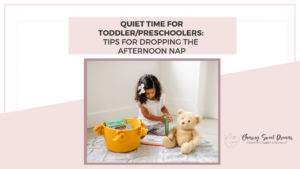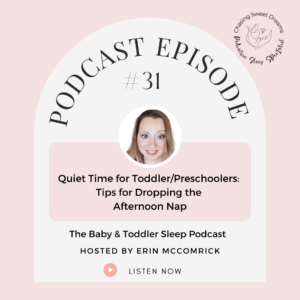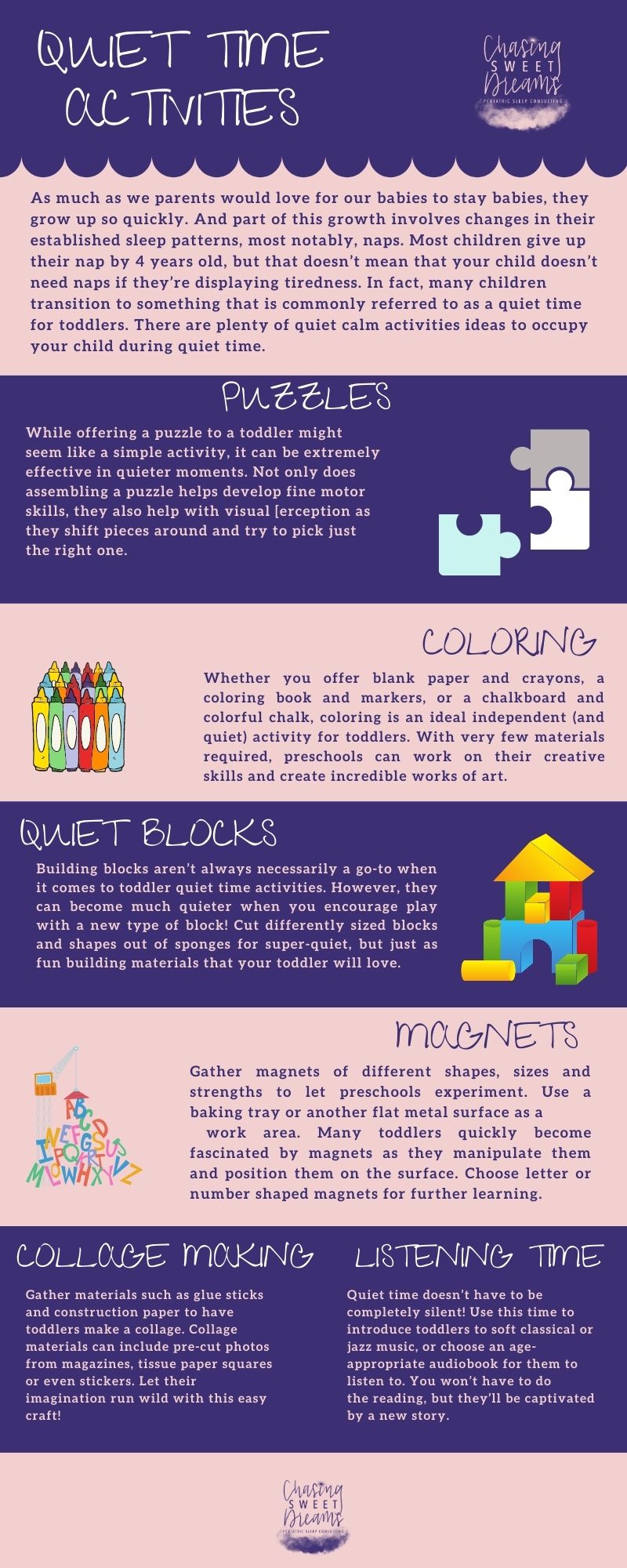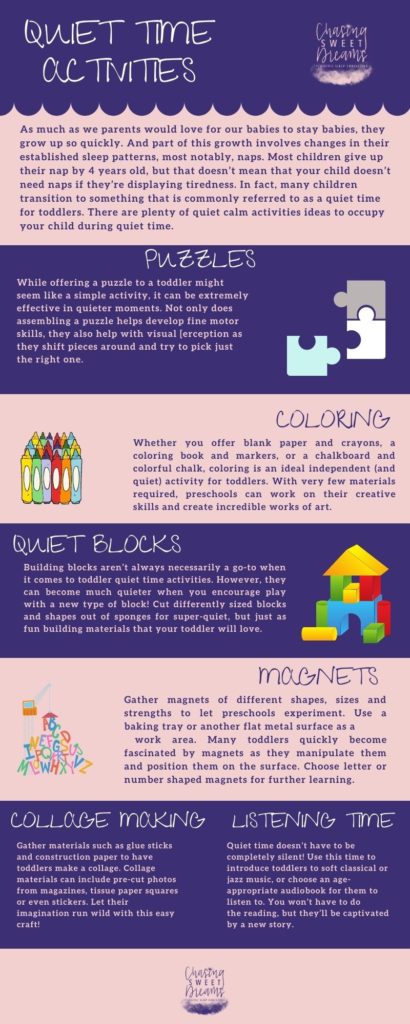
Quiet Time for Toddler/Preschoolers: Tips for Dropping the Afternoon Nap
For parents of toddlers/preschoolers, the idea of giving up naps can be daunting. However, there are some tips and tricks that can make the process a little bit easier. In fact, many children transition to something that is commonly referred to as a quiet time for toddlers/preschoolers.
These periods of quiet time are particularly essential to those children who still have ‘nap days’. This often occurs when your child is transitioning out of afternoon naps, but may actually ask for, or show tired signs — which indicate they need a nap — a few days a week. It’s actually quite common for preschoolers to need afternoon sleep two or three days a week just to recuperate and be their happy selves. Quiet time is not only beneficial for kids it also gives parents a much-needed midday break.

In this blog, we will cover the following about transitioning from nap to quiet time for toddlers/preschoolers.
- Signs To Look For
- How To Start Quiet Time
- Model Independent Play
- Treat Quiet Time Like A Nap
- Choose Activities
- Have A Set Space
- Set Your Expectations
- Be Consistent, Be Flexible
>>>>>>Download the “How to Overcome Toddler Obstacles” guide here!! <<<<<!
Signs To Look For
You may be seeing signs your toddler/preschooler is ready to drop their nap, or maybe just some days. The following may be indicators that your child would benefit from quiet time, or even transitioning to “nap days”, rather than a set nap every day:
- She is regularly fighting the bedtime routine.
- She has suddenly become a bedtime jack-in-the-box, popping in and out of her bed.
- You can hear her singing, laughing, playing, talking, or getting up and down for an hour (or more!) before she finally falls asleep at night.
Remember, your child is used to naps. That means that your child is used to taking their nap at the same time every day. It’s part of their routine. And then suddenly, they no longer need a nap.
This is the perfect time to introduce quiet time. Rather than reworking the routine, you can begin to gently introduce the idea of quiet time. But, how can we gently encourage quiet time?
How To Start Quiet Time
Some children will relish the idea of quiet time. Others…well, not so much. To avoid resistance, start quiet time out slowly, perhaps in 15-20 minute increments. Allow your child to play quietly, and do a timed check. Pop your head into the room, acknowledge what a great job he is doing of playing quietly, and if you feel it is called for, suggest alternative items that he may play with. If he’s been reading books, maybe he’d like to play with the blocks.
Model Independent Play
Independent play is important for your child’s development, and it’s central to effective quiet time. If you find that your little one is struggling to stay engaged for more than a few minutes without your help, you may want to help them exercise their imagination by practicing the activities that you have available for quiet time. Build a bridge with blocks, have her read you a story, or put on a puppet show, then slowly bow out of the activity, and allow your child to play independently. This will help set the stage for quiet time and spark her imagination. Independent play is important for your child’s development, and it’s central to effective quiet time for toddlers.
Treat Quiet Time Like A Nap
At its core, quiet time is downtime for your child. It’s a time during the day when they have an opportunity to rest their busy little bodies and minds. The length of quiet time can range anywhere from 45 minutes to 2 hours, depending on the child. Proper use of quiet time can actually make your late afternoon and evening activities more pleasant, as well as help with bedtime.
You can even set the stage for quiet time by utilizing parts of your child’s naptime routine — such as a snuggle and story — but letting them know that they are allowed to play quietly in their room, or snuggle in the recliner reading a book instead of sleeping if they choose.
Choose Activities

Many parents wonder what activities to employ during quiet time for toddlers. At the risk of being obvious, I recommend a quiet activity or selection of activities. Good choices include books, coloring (if you can trust them not to color the walls), playing with blocks or Legos, dolls, trains, puzzles, puppets, etc. The options are really limitless, as long as the child is calm, quiet, and playing in the designated quiet time area.
Puzzles
While offering a puzzle to a toddler may seem like an overly simple activity, it can be extremely effective for quieter moments. Not only does assembling a puzzle help toddlers develop fine motor skills, but they also help strengthen special orientation and visual perception as they shift pieces around and try to pick just the right one out of the pile.
Coloring
Whether you offer blank paper and crayons, a coloring book and markers, or a chalkboard and colorful chalk, coloring is an ideal independent (and quiet) activity for toddlers. With very few materials required, preschools can work on their creative skills and create incredible works of art.
Quiet Blocks
Building blocks aren’t always necessarily a go-to when it comes to toddler quiet time activities. However, they can become much quieter when you encourage play with a new type of block! Cut different sized blocks and shapes out of sponges for super-quiet, but just as fun building materials that your toddler will love.
Magnets
Gather magnets of different shapes, sizes, and strengths to let preschools experiment. Use a baking tray or another flat metal surface as a work area. Many toddlers quickly become fascinated by magnets as they manipulate them and position them on the surface. Choose letter or number shaped magnets for further learning.
Collage Making
Gather materials such as glue sticks and construction paper to have toddlers make a collage. Collage materials can include pre-cut photos from magazines, tissue paper squares, or even stickers. Let their imagination run wild with this easy craft!
Listening Time
Quiet time doesn’t have to be completely silent! Use this time to introduce toddlers to soft classical or jazz music, or choose an age-appropriate audiobook for them to listen to. You won’t have to do the reading, but they’ll be captivated by a new story.
Some parents find that their children cannot relax if they have too many options available, and that’s okay. In these instances, consider having a quiet time box that contains activities that are only accessible during quiet time. Be sure to explain to your child that it’s quiet time, and you have a super-special box of activities just for this time.
To make sure that your child doesn’t get bored, try to rotate toys on a semi-regular basis. This is especially helpful if you use a quiet time box.
HAVE A SET QUIET TIME SPACE
The best place for quiet time is in your child’s room, where you can provide dimmed lights, and familiar pre-nap preparations to help ease him into quietly playing or reading. Having quiet time in his room will also allow your child to comfortably go to sleep should he choose — provided that he’s not in a crib.
If your child has transitioned to quiet time and is still in a crib, you can provide activities for him in his crib, and let him know that it’s nap time, but if he can’t sleep, then he can read a book, do a puzzle, or play with his puppets.
If you find that his room has too many toys, consider having quiet time in another room, or moving the toys so that he does not become over-stimulated while he’s trying to rest.
If the child shares a room with a napping sibling, the room will not be the best place for quiet time because quiet time should definitely overlap with naptime for mama’s sanity. If you have an office, a spare bedroom, or a playroom, any of these places can work for quiet time.
USE DRAMATIC WAKE-UP
Quiet time for toddlers ends when you go into your child’s room to tell them how proud you are that they played so quietly. Tell them that it’s time for the next portion of your daily routine. Many families find that having a snack after quiet time is helpful.
If your child is fairly independent, some families find that it helps to use a toddler clock, radio, or light to help alert the child to the end of quiet time. Allowing your child the independence to end quiet time “on her own” will cut back on questions about when she can go outside, or come downstairs.
EXPECTATIONS FOR QUIET TIME
Quiet time is not the same as naptime. Your child is mobile and playing independently, which means that the rules need to change a bit. Keep your expectations simple and easy to understand. Some parents find that sticking to 3-5 rules is helpful. Some key expectations for quiet time for toddlers:
- She needs to stay in his room.
- If she needs something, she should come and get you rather than yelling. Consider setting some limits regarding the number of times she can come and get you if this begins to get out of hand.
- The activities for quiet time need to be quiet. That means no screaming, yelling, or playing the drums HAHA.
- Set potty rules. Does he need your assistance? Is he able to quietly use the toilet on his own, should the need arise?
You may also want to consider whether or not you allow snacks and drinks. Many families find that having lunch directly before quiet time helps to ensure that your child has a full tummy, and will limit the number of crumbs that end up in their bedrooms. Other families allow small, quiet, snacks.
Whatever your quiet time rules, be sure that establish them at the beginning of each and every quiet time. Just make it part of your preparation routine.
BE CONSISTENT, BE FLEXIBLE
I find myself saying it time and time again, but it’s the truth. Children are all about consistency. Just as you were consistent with naps, be consistent with quiet time for toddlers. You may find that your child will eventually look forward to his quiet time.
Just like naptimes, there will be some days that are just ‘off’. Expect that some days will be better than others and that your child may only be able to handle a maximum of 45 minutes playing independently, while other children are perfectly happy with a full 2 hours. Figure out what works for your family, and enjoy the peace and quiet.
Bedtime Tip
If your child is not napping or having quiet time during the day, you might need to move bedtime up a bit. You will want to play that by ear and see how your child does, but if your child is having a hard time in the evening, it is good to do bedtime 30-60 minutes earlier than usual.
Final Thoughts
If you notice your child is around 3/4 years old, fighting bedtime routine, playing jack-in-the-box for naptime or bedtime, and singing, laughing, playing, talking, or getting up and down for an hour (or more!) before she finally falls asleep at night it’s a great time to introduce quiet time.
I have so much more I want to teach you about baby and toddler sleep and how you can help your baby!
Follow me on Instagram and check out my daily stories.
Do you like what I have to say? Send me an email or set up a discovery call! I am here for you!
Sending sleepy vibes and sweet dreams your way!
Erin McCormick
Your Pediatric Sleep Specialist

[/vc_column_text]

